While Plextor doesn’t have an extensive range of SSD offerings in the consumer space, the drives they do bring to market have historically been very good. In fact, Plextor has eeked more performance out of the Marvell 9174 (which at this point, if not old is certainly near end of life with the successor announced a few months ago) than anyone else using that particular SSD controller. Plextor also boasts industry leading internal validation and other testing to make sure their SSD reliability is top of market. The new PX-M5S continues the Plextor mantra of delivering incremental improvements over time. While not a revolutionary change, the M5S SSD is a perfect example of progressive SSD engineering, delivering an end product that’s expected to be a step better than prior generations.
When compared to the prior generation M3S, consumers aren’t going to notice much change. The key difference between M5S and the M3S is the NAND. Plextor switched from using Toshiba 24nm in the M3S to Micron 25nm for M5S. The M5S also sports a new firmware, with modest stability and performance enhancements. Overall though the drives are very similar; both offer a 2.5″ 9.5mm SATA form factor, Marvell 9174 controller and three year warranty.
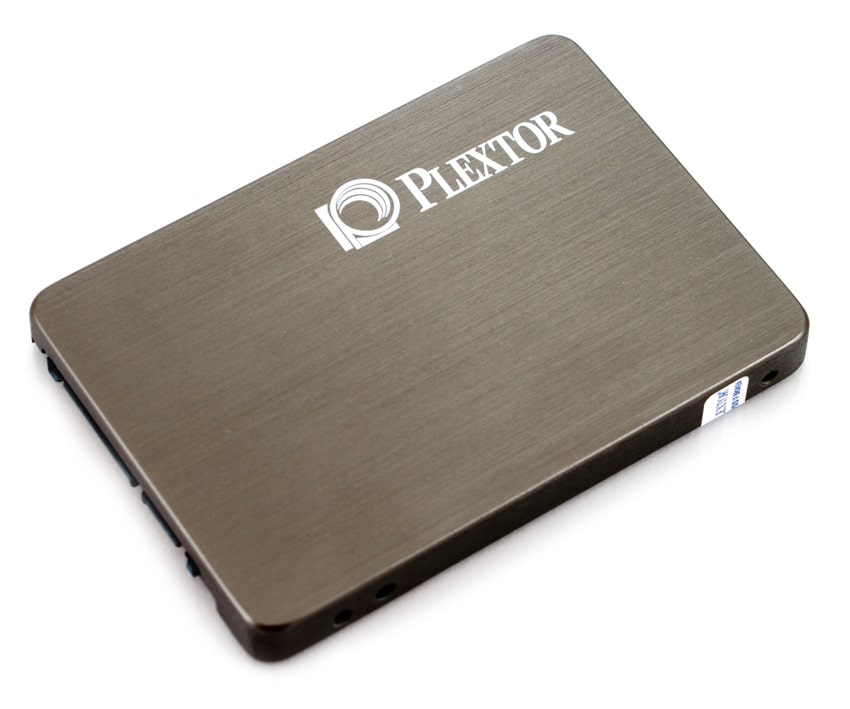
Plextor M5S Specifications
- Capacities
- 64GB (PX-64M5S)
- Sequential Read (MB/s) – 520
- Sequential Write (MB/s) – 90
- Random Read (IOPS 4K) – 61,000
- Random Write (IOPS 4K) – 25,000
- Buffer Memory (DDR3) – 128MB
- 128 GB (PX-128M5S)
- Sequential Read (MB/s) – 520
- Sequential Write (MB/s) – 200
- Random Read (IOPS 4K) – 71,000
- Random Write (IOPS 4K) – 51,000
- Buffer Memory (DDR3) – 256MB
- 256GB (PX-256M5S)
- Sequential Read (MB/s) – 520
- Sequential Write (MB/s) – 390
- Random Read (IOPS 4K) – 73,000
- Random Write (IOPS 4K) – 70,000
- Buffer Memory (DDR3) – 512MB
- Power Consumption (Typical): 0.7W (Idle); 2.8W (Active)
- Temperature (Operating): 32 ºF to 158 ºF (0 ºC to 70 ºC)
- Temperature (Non-operating): -40ºF to 185 ºF (-40 ºC to 85 ºC)
- Shock: 1,500G/0.5 ms
- Vibration (Operating): 7~800Hz, 2.17G (RMS)
- MTBF: 1.5 million hour
- Form Factor: 2.5″
- Power Connector: 15-pin SATA connector for DC 5V input
- Data Connector: 7-pin SATA connector
- Dimensions (W x H x D): 69.85 x 100 x 9.5 mm
- Weight: 2.54 oz / 75 g
- Warranty: 3 years
- 64GB (PX-64M5S)
Build and Design
Plextor uses an all-metal body with the PX-M5S, giving it a durable feel and a stylized look. The metal alloy used is presented with a brushed metal finish, adding a bit of texture and a very solid feel with the drive in your hand. Both top and bottom match in color and finish, which adds to the appearance and really rounds off this SSD.
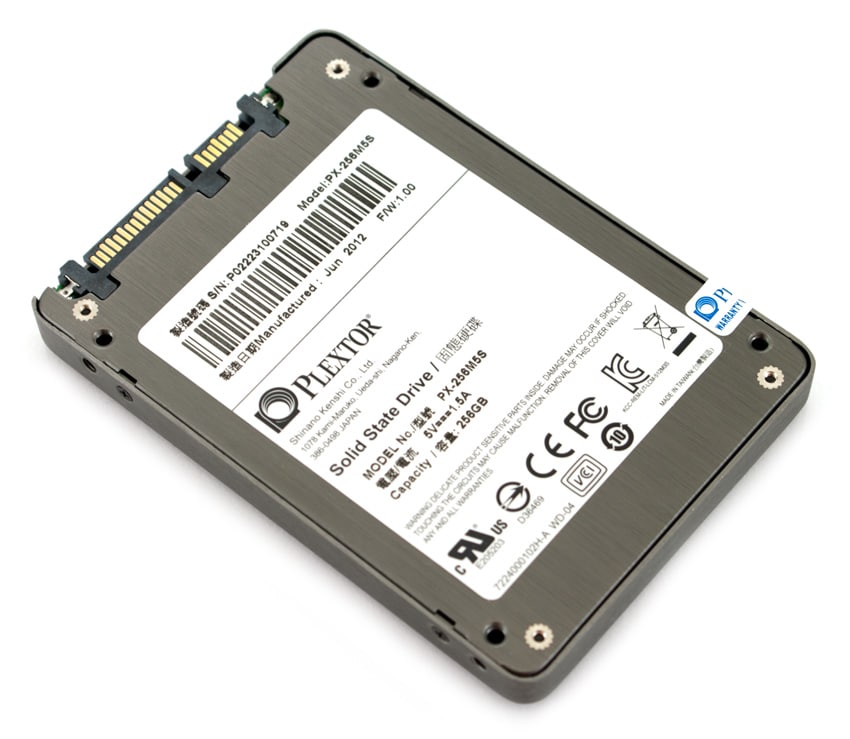
The side of the drive shows off the screws that hold the two case halves together, as well as standard horizontal mounting points. The bottom also includes mounting points as well for attaching this drive to sleds and hot-swap bays. The front of the drive includes the standard SATA power and data interface, with no service pins visible or other attributes.

Taking the Plextor PX-M5S apart is very simple, but voids your warranty in the process. To split the SSD apart, you simply remove the four Phillips head screws from the perimeter of the drive (one breaking the warranty voiding sticker) and then use a fingernail to split the case open.
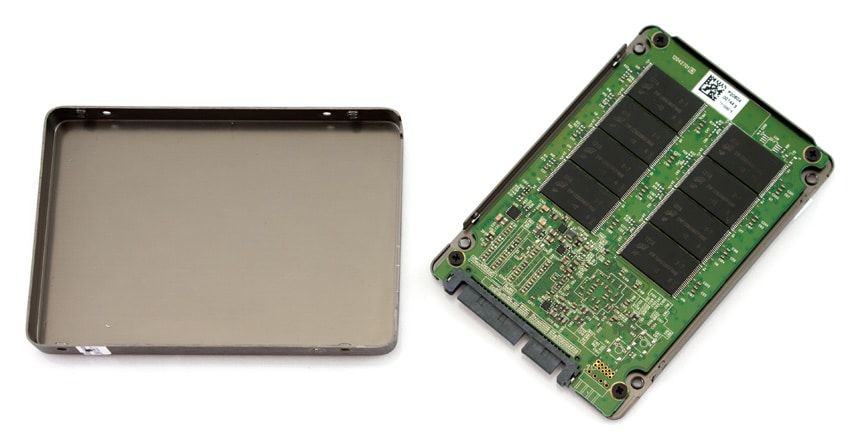
Inside the PX-M5S we find a 16-piece NAND configuration unlike the 8-piece layout seen inside the older PX-M3S. This setup utilizes one side of the circuit board for the flash and RAM, leaving the bottom open for just the controller. The controller is the tried and true Marvell 88SS9174-BKK2 SATA 6Gb/s processor. The main difference between the M3S and the M5S is the switch from 24nm Toshiba toggle NAND to synchronous 25nm Micron NAND.
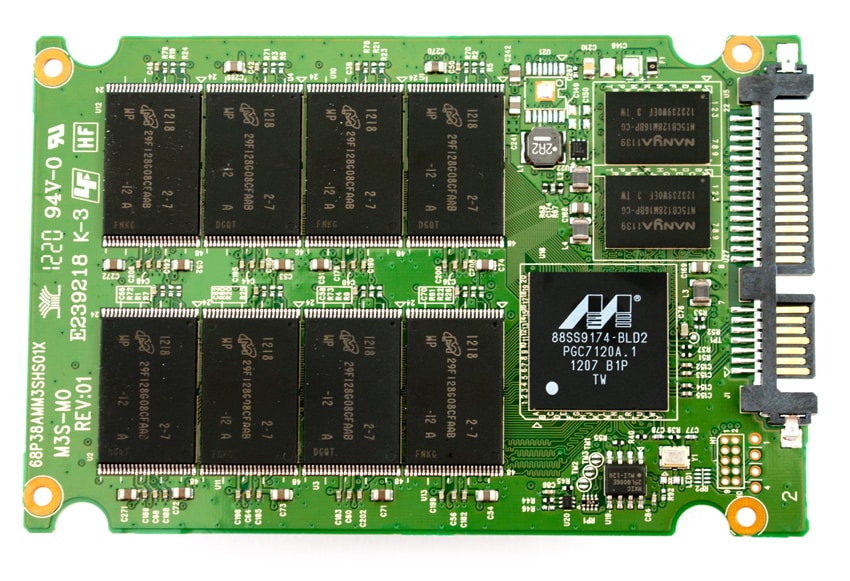
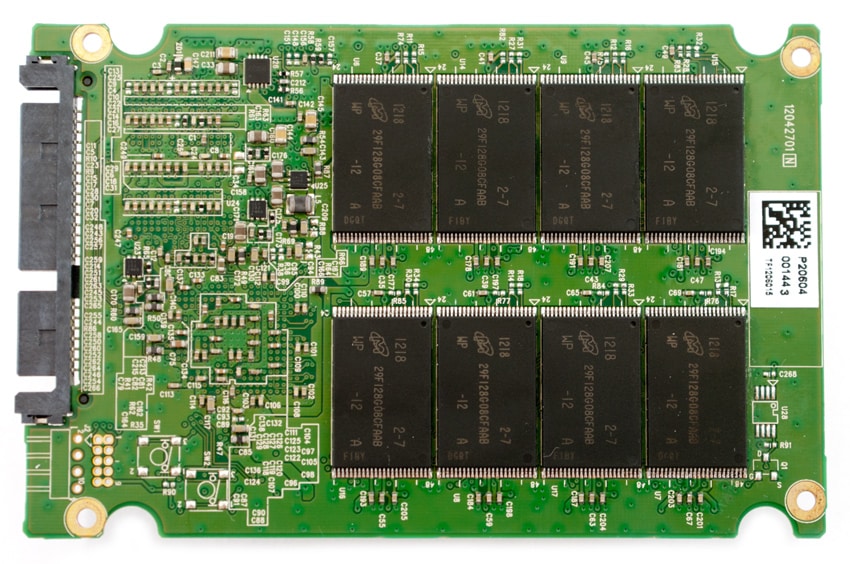
Synthetic Benchmarks
The Plextor M5S uses Micron’s 25nm synchronous MLC NAND, a Marvell 9174 controller and a 6.0Gb/s SATA interface; our review unit is 256GB. The comparables used for this review include the following recently tested SSDs: Intel SSD 520 (240GB, SandForce SF-2281, Intel 25nm NAND, SATA), OCZ Vertex 3 MAX IOPS (240GB, SandForce SF-2281, Toshiba 32nm MLC NAND, SATA), Plextor PX-M3P (256GB, Marvell 9174, Toshiba 24nm MLC Toggle NAND, SATA), the Samsung 830 (256GB, Samsung 3-core MCX controller, Samsung 2x nm Toggle NAND Flash, SATA), and the OCZ Vertex 4 (512GB, Indilinx Everest 2, Intel 25nm MLC NAND, SATA). All IOMeter figures are represented as binary figures for MB/s speeds. All SSDs were tested on our client testing platform.
Our first test is a large-block sequential transfer, which Plextor advertises as 520MB/s read and 390MB/s write.
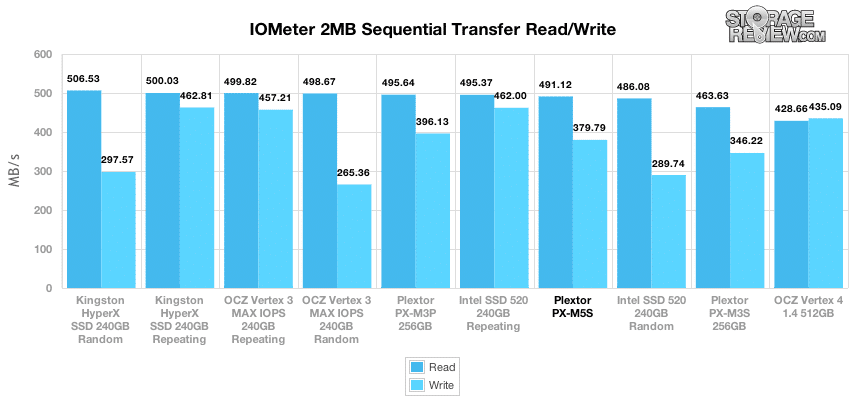
In our sequential transfer test we measured speeds of 491MB/s read and 379MB/s write. Compared to the M3S, both read and write speeds improved.
Our next test looks at large-block random transfers, which the M5S also improved on from the M3S.
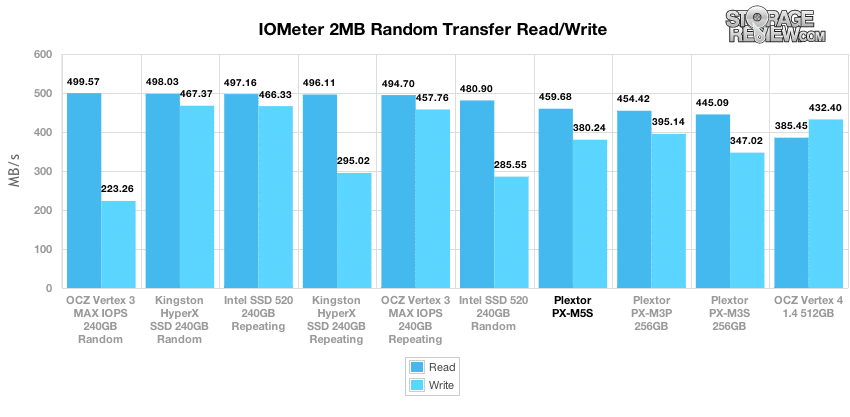
We measured large-block random transfer speeds of 459MB/s read and 380MB/s write on the M5S, compared to 445MB/s read and 347MB/s write on the M3S.
Our next test looks at small-block transfers at a low queue depth, using a 4K transfer in IOMeter.
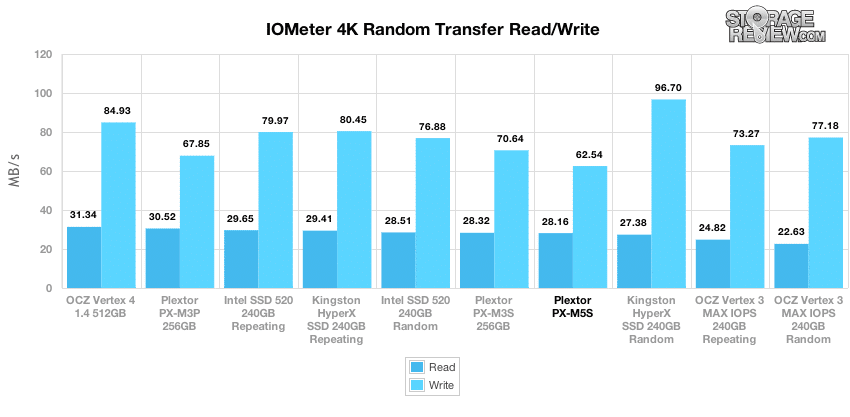
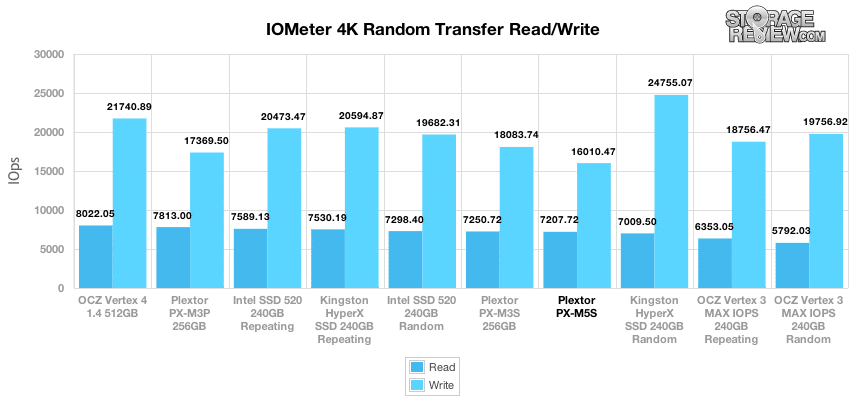
At a queue depth of 1, the Plextor M5S measured 7,207 IOPS read and 16,010 IOPS write, versus 7,250 read and 18,038 write from the M3S.
The remaining portion of synthetic benchmarks scales the queue depth from 1 to 64 or 128, to show how well the drives’ performance scales under load.
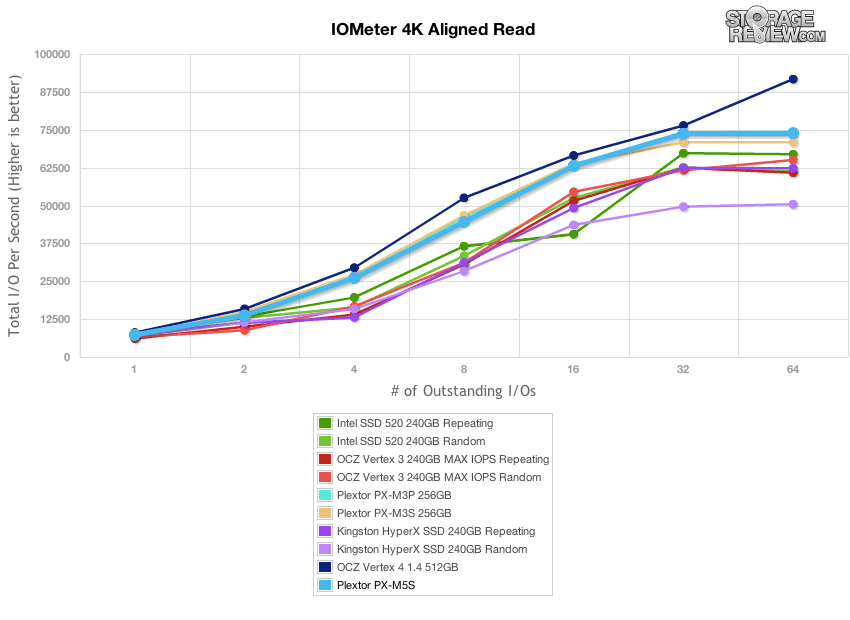
In a 4K random read setting, the Plextor M5S offered an edge over M3S, peaking at 73,886 IOPS, versus 73,323 IOPS from the M3S. Plextor quotes the top speed of the M5S in a 4K random read workload at 73,000 IOPS, which was easily reached in our tests.
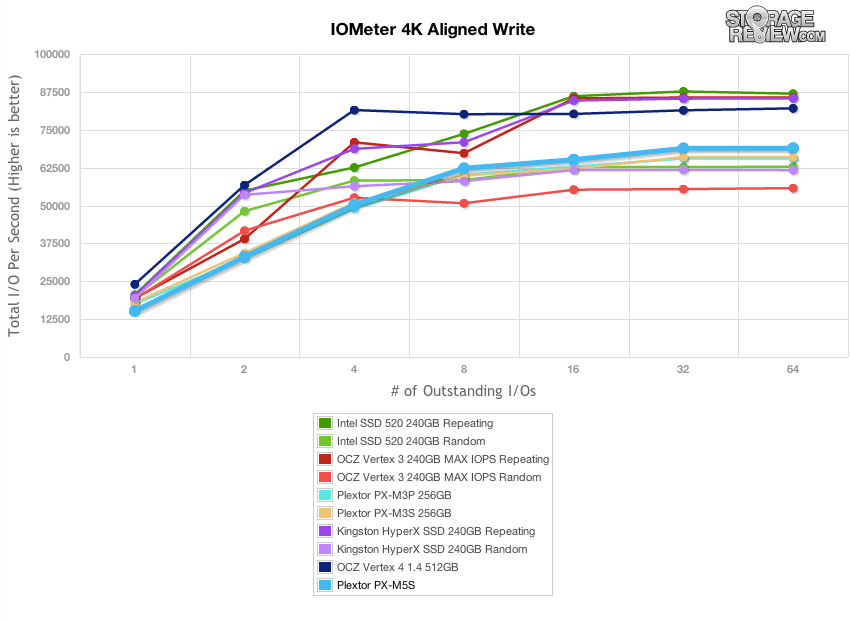
Switching to a random 4K write workload, the Plextor M5S scaled very well, peaking at 68,898 IOPS (70,000 IOPS rated), versus 65,550 IOPS from the M3S. Both drives scaled performance well, although the M5S had the edge over the M3S at the highest queue depths.
Expanding our QD1 4K test, we look at write latency of each SSD. Lower numbers are better, since it means less wait time for activity to process. Max latency is also important, although that number can change as the NAND wears over time. The Plextor M5S came in with latency higher than the M3S, and at the bottom of this group of SSDs. We measured an average latency of 0.062ms from the M5S with a peak latency of 6.55ms.
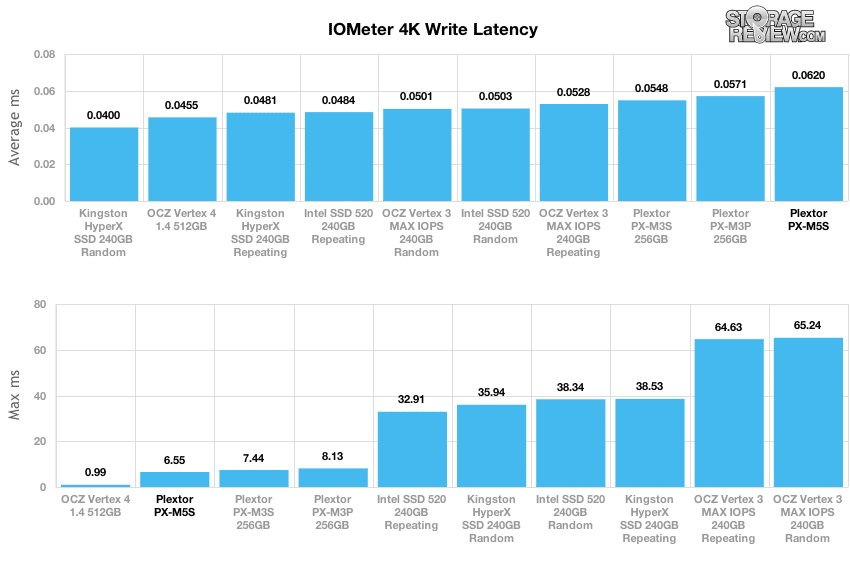
Our last series of synthetic benchmarks compare the hard drives in a series of server mixed-workloads with a queue depth of ranging from 1 to 128. Each of our server profile tests has a strong preference towards read activity, ranging from 67% read with our database profile to 100% read in our web server profile. The new Plextor M5S held its own very well, although in many of the mixed workloads, the Vertex 4 and SandForce SF-2200 models surpassed it at higher queue depths.
The first is our database profile, with a 67% read and 33% write workload mix primarily centered on 8K transfer sizes.
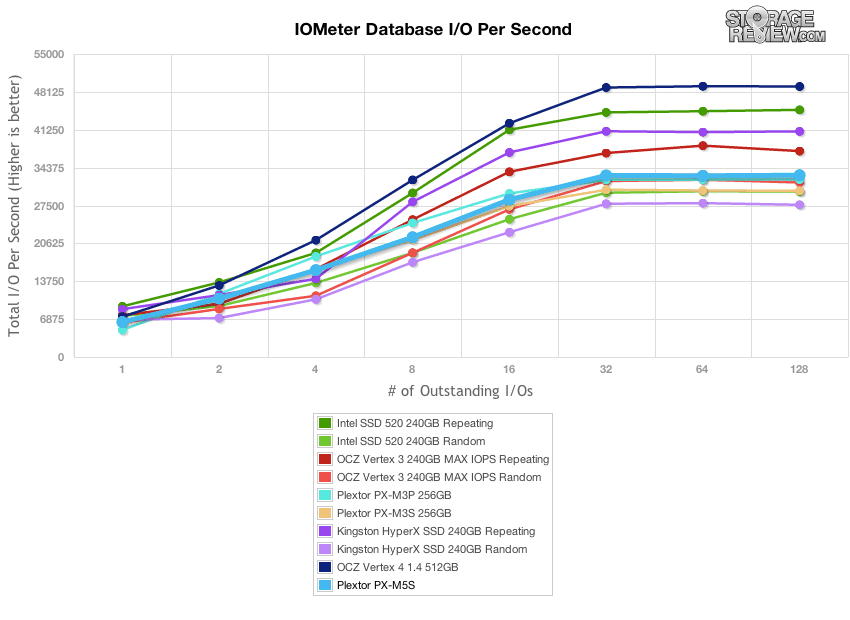
The next profile looks at a file server, with 80% read and 20% write workload spread out over multiple transfer sizes ranging from 512-byte to 64KB.
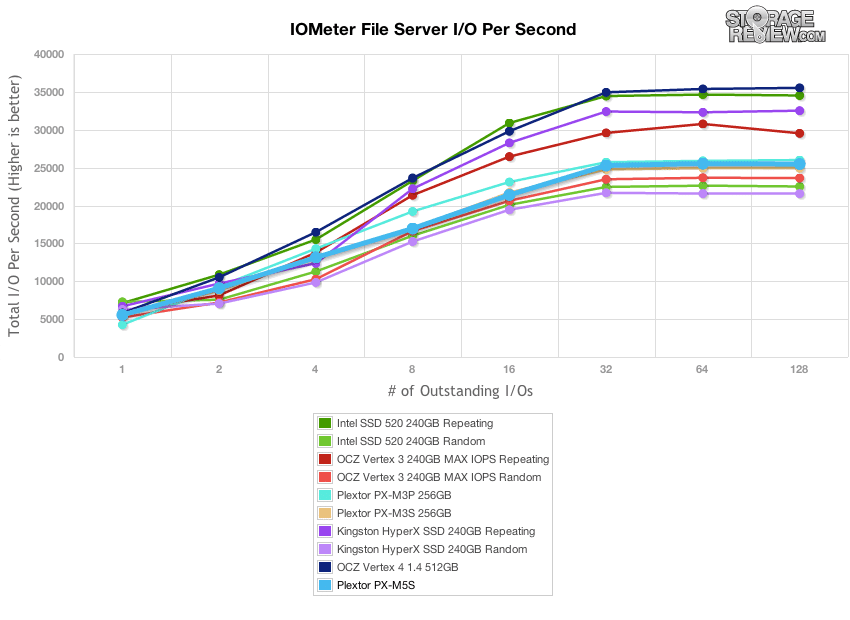
Our web server profile is read-only with a spread of transfer sizes from 512-byte to 512KB.
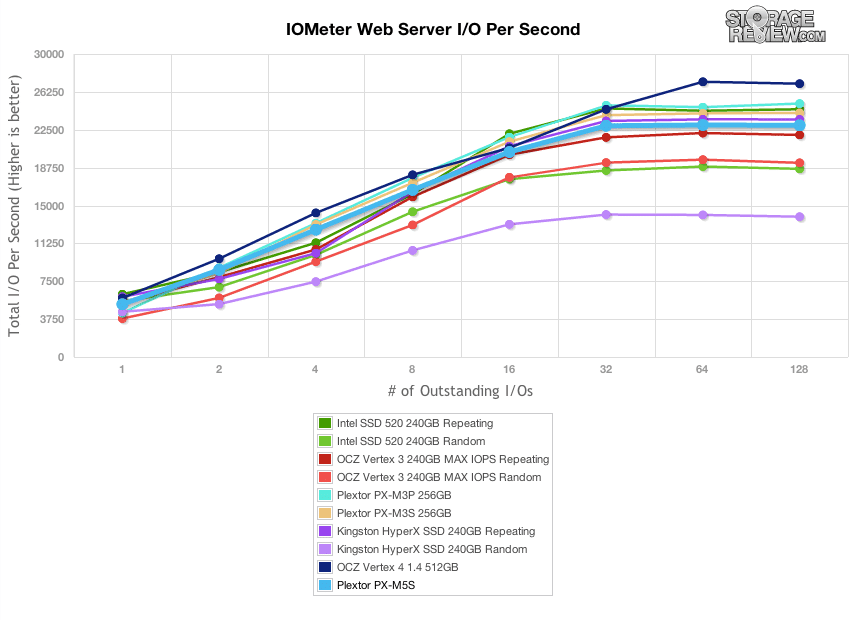
The last profile looks at a workstation, with a 20% write and 80% read mixture using 8K transfers.
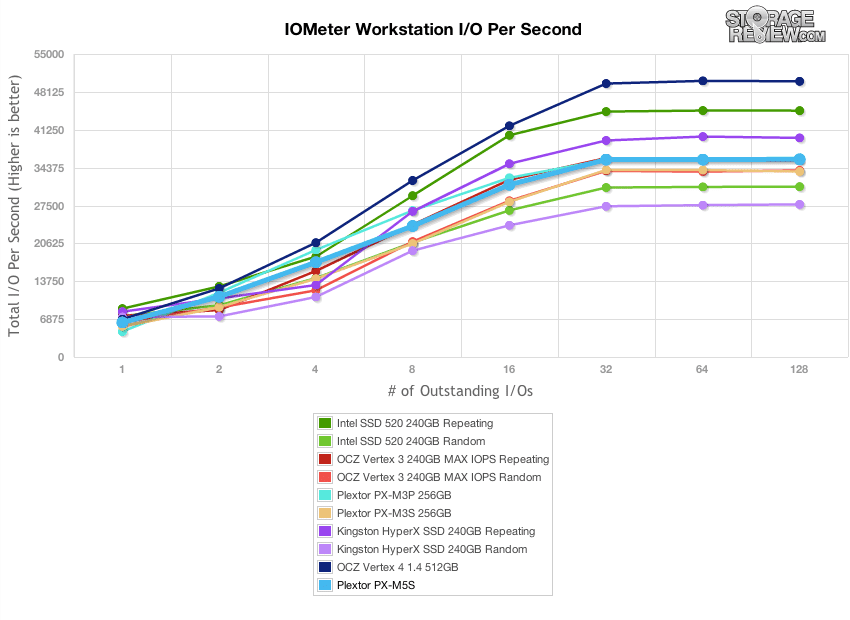
Real-World Benchmarks
For the average consumer, trying to translate random 4K write speeds into an everyday situation is pretty difficult. It helps when comparing drives in every setting possible, but it doesn’t exactly work out into faster everyday usage or better game loading times. For this reason we turned to our StorageMark 2010 traces, which include HTPC, Productivity, and Gaming traces to help readers find out how a drive might rank under their conditions.
The first real-life test is our HTPC scenario. In this test we include: playing one 720P HD movie in Media Player Classic, one 480P SD movie playing in VLC, three movies downloading simultaneously through iTunes, and one 1080i HDTV stream being recorded through Windows Media Center over a 15 minute period. Higher IOps and MB/s rates with lower latency times are preferred. In this trace we recorded 2,986MB being written to the drive and 1,924MB being read. Our second real-life test covers disk activity in a productivity scenario. For all intents and purposes this test shows drive performance under normal daily activity for most users. This test includes: a three hour period operating in an office productivity environment with 32-bit Vista running Outlook 2007 connected to an Exchange server, web browsing using Chrome and IE8, editing files within Office 2007, viewing PDFs in Adobe Reader, and an hour of local music playback with two hours of additional online music via Pandora. In this trace we recorded 4,830MB being written to the drive and 2,758MB being read.
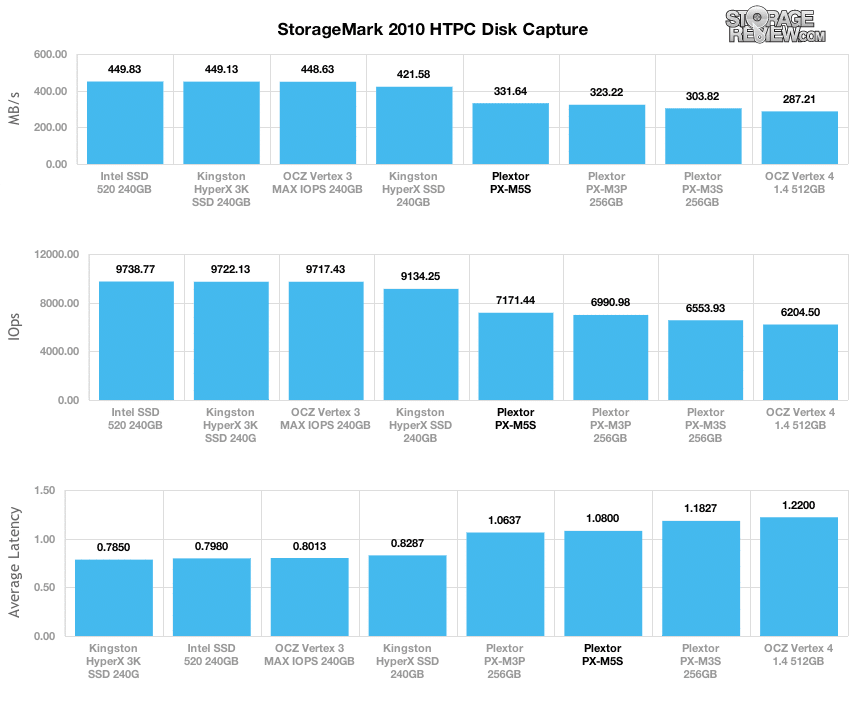
In our HTPC trace, the newer M5S edged out the M3S with a small lead, measuring 331MB/s average compared to 303MB/s before.
Our second real-life test covers disk activity in a productivity scenario. For all intents and purposes this test shows drive performance under normal daily activity for most users. This test includes: a three hour period operating in an office productivity environment with 32-bit Vista running Outlook 2007 connected to an Exchange server, web browsing using Chrome and IE8, editing files within Office 2007, viewing PDFs in Adobe Reader, and an hour of local music playback with two hours of additional online music via Pandora. In this trace we recorded 4,830MB being written to the drive and 2,758MB being read.
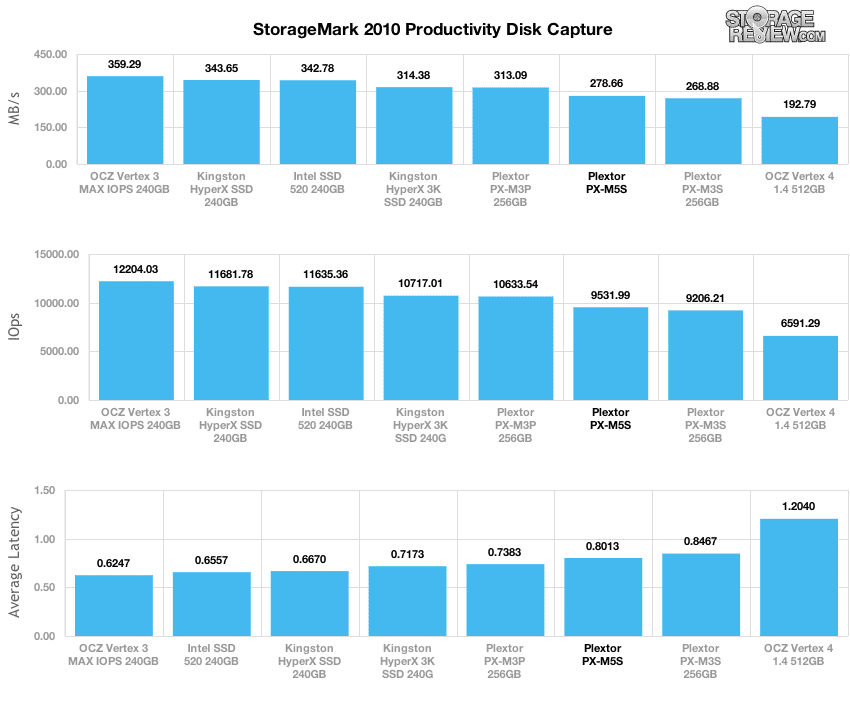
In our Productivity setting, the Plextor M5S slipped behind the older M3S with toggle NAND, averaging 278MB/s in combined read/write speed versus 313MB/s of the M3S.
Our third real-life test covers disk activity in a gaming environment. Unlike the HTPC or Productivity trace, this one relies heavily on the read performance of a drive. To give a simple breakdown of read/write percentages, the HTPC test is 64% write, 36% read, the Productivity test is 59% write and 41% read, while the gaming trace is 6% write and 94% read. The test consists of a Windows 7 Ultimate 64-bit system pre-configured with Steam, with Grand Theft Auto 4, Left 4 Dead 2, and Mass Effect 2 already downloaded and installed. The trace captures the heavy read activity of each game loading from the start, as well as textures as the game progresses. In this trace we recorded 426MB being written to the drive and 7,235MB being read.
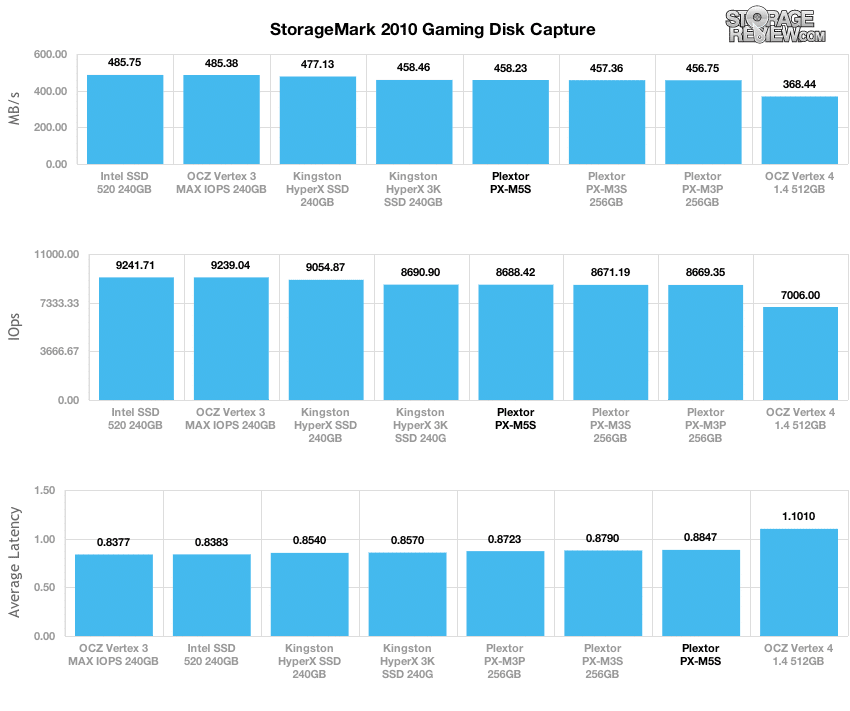
In a read-intensive gaming setting, the Plextor M5S performed very similarly to the M3S and M3P, measuring 458MB/s compared to 457MB/s or 456MB/s respectively.
Apple Performance and Compatibility
Expanding on our Windows-environment testing on commodity hardware, we also include Apple-specific testing on a current-generation consumer Mac Mini. This platform uses the unused internal SATA connection combined with a custom breakout cable to test 2.5-inch SSDs and hard drives with the native secondary internal connection.
During our testing, we found a compatibility issue with the Plextor M5S SSD. We were unable to run basic performance analysis tests such as Blackmagic Disk Speed Test or AJA System Test. After partitioning the M5S on the system, it would become unresponsive to both read and write activity. Swapping it back into our Windows environment saw none of these problems, nor did other SSDs we tested on the Mac Mini. Plextor is attempting to replicate our issue, but says they’ve seen no problems when using the drive as primary in the MacBook Pro.
Power Consumption
When looking at any modern SSD, power consumption is a huge deciding factor for many mobile shoppers, since the drive itself can make up a large portion of the total power used in a given notebook. In our power consumption tests we look at how much a given drive draws during read and write activities, as well as startup requirements and idle.

Power consumption increased somewhat comparing the M5S to the older M3S in read and write settings. In our tests we measured write activity at 4.12 watts, compared to 3.58 watts on the M3S. Read activity measured 2.31 watts, compared to 1.98 watts previous. Random read activity measured 0.82 watts, versus 0.77 watts prior, although idle activity stayed roughly the same measuring 0.34 watts on the M5S versus 0.35 watts.
Conclusion
The Plextor M5S shows us that there’s still a little more upside available to the Marvell 9174, which is pretty impressive given its time on market. While the main change in the M5S from the M3S (note some Asian companies prefer not to use the unlucky number four in their model numbers) is a NAND edit, Plextor has further tweaked their firmware to eek out a little more performance in most areas.
Our benchmarks show gains in most categories, although most were subtle especially in our mixed workloads. In many cases the M5S matched the performance of the M3S across the board. The one area that the M5S did slip in was low-queue depth random workloads, where the toggle NAND equipped M3S was able to beat it. Power consumption also increased, which wasn’t a huge surprise with more silicon on the circuit board needing to be powered, with a sixteen piece NAND configuration over the eight-piece prior. Overall the M5S offers a more subtle increase in performance, most users are unlikely to be able to tell a difference.
Pros
- Slightly faster than the older M3S in most categories
- Another stable SSD built on a trusted platform
Cons
- Higher power consumption than M3S
- Slower random 4K read/write speeds at low queue depths
Bottom Line
The Plextor M5S swaps out NAND and offers an improved firmware from the M3S it replaces. There are generally performance increases throughout, but they’re small, which is to be expected given the age of the processor being used. The biggest gain is in pricing, right now the M5S is a little cheaper across the board, with further price reductions likely as the drive spends more time in market. Overall, the M5S is another solid offering from Plextor and is worthy of consideration for consumers who want performance and reliability.
Plextor M5S at Amazon.com



 Amazon
Amazon